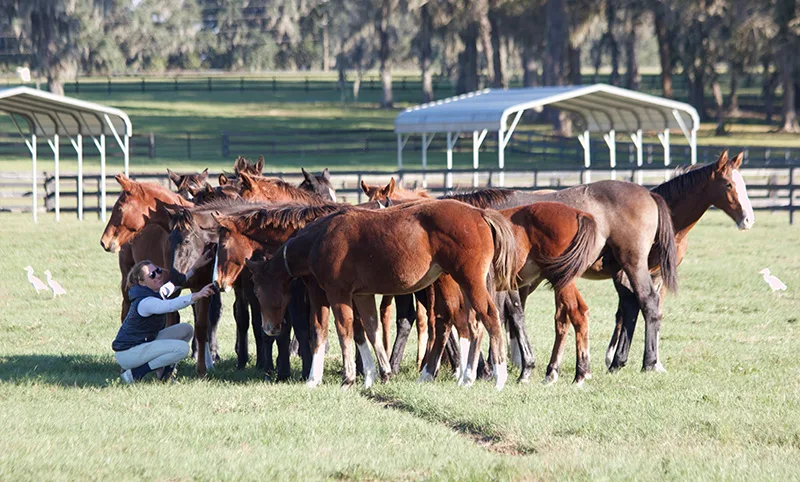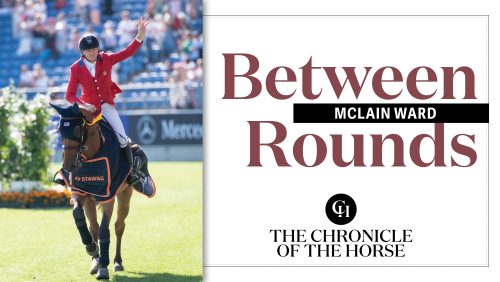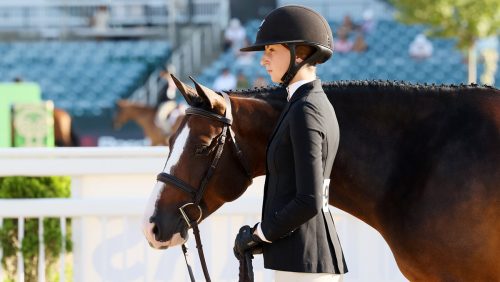In the summer of 2015, Emil Spadone flew to the winter base of his Redfield Farm in Ocala, Florida, from his summer home in Califon, New Jersey, to check on his breeding operation. There he met up with Alex Bell, who runs the day-to-day operations at the Redfield Farm breeding program, and she posed a bold question to her boss.
“I asked, ‘Do you think I could partner on a horse with you?’ ” recalled Bell. “He said, ‘Well, let’s walk through the fields, and you pick one.’ ”
Bell already had a youngster in mind, and when they got to the yearling paddock, she pointed at a chestnut colt by Spadone’s homebred stallion Maximus and out of McLain Ward’s FEI World Cup Qualifier winner Phillipa (by Electro). He was one among dozens, but Bell had no problem picking him out.
“I loved Phillipa, and I loved [her baby] from the day he was born,” said Bell. “He was one that you would walk through the field, and he always stands out because of his looks and his conformation. He has the kindest eye.”
So Spadone agreed to partner with Bell on the colt, named Mr. Manhattan. Fast-forward six months, and Spadone and his team free-jumped the crop of 2-year-olds to see what kind of ability they had.
“We only made him jump over [a crossrail], and he said, ‘OK, that’s enough,’ ” recalled Bell. “You could see his talent.”
A few years later that same horse would have a storybook start to his career that included topping the 2020 3’3″ green hunter, money won, USEF Horse of the Year standings; earning the 2020 $25,000 North American Green Hunter 3′ and 3’3″ Championship at Capital Challenge (Maryland); and winning the 2022 3’6″ green hunter championship at the Pennsylvania National with Daniel Geitner aboard. He finished the 2022 season on top of the USEF HOTY 3’6″ green hunter, by increment, standings.
Johnny Barker, who trains the 8-year-old gelding owned by Martin Schlaeppi, described Mr. Manhattan as a once-in-a-lifetime horse. His experience with “Manhattan” and other Redfield Farm offspring like Memphis Blue (Maximus—Envy, Casall), who finished seventh in the country in the 3′ green, money won, HOTY standings in 2020, have made him a believer in Spadone’s breeding program.
“Emil is breeding these horses that are bred a little more true to form, I think,” said Barker. “In other words, if you want a hunter, he’s trying to breed one to be a hunter. It makes it easier to look for them.”

Redfield Farm offspring Mr. Manhattan’s year in the 3’6″ green hunter division included winning the division championship at the Pennsylvania National with Daniel Geitner up. Kimberly Loushin Photo
‘I’m A Dreamer’
More than two decades ago, Spadone started traveling to Europe to find hunters, jumpers and equitation horses, and he’s seen the market change considerably over that time.
“You could find [potential] hunters and equitation horses, and they were reasonable,” he recalled. “You could bring them home and develop them and buy a young horse and do really well. Now—you can’t blame them—but the Europeans understand the market for these hunters is so strong. When they feel like they have a hunter [it’s very expensive]. It’s very hard to find anything that’s reasonably priced.
“Someone sent me a video of a 3-year-old the other day for 100,000 Euros,” he added “They said that they know they’re going to get it, so they’re not taking less. I said that it looks really nice, but I can’t afford it. It’s too risky for me.”
Spadone still has a busy importing business—he estimates he selects and imports 60 to 75 horses a year, and he’s a managing partner of the international horse shipping company Horseflight—but his breeding operation has grown by leaps and bounds. He’ll harvest embryos from mares he likes to avoid interfering too much with their show career.
ADVERTISEMENT
“I’m a big believer in the mare,” he said. “First of all, with a hunter, I try to get as good a mover as possible; I think that really helps.
“I don’t want to breed just any mare,” he continued. “I want type. I want movement. I want them to be able to jump and be athletic. We really try to be as choosey as we can with the mares that we breed to, at least for our own program.”
He started about 17 years ago breeding three or four horses a year, and he struck gold almost immediately. He bred the stallion Mynos to a Cor De La Bryere mare named Corallie. He had imported both horses and had a special place in his heart for the mare.
“I’m a little bit of a dreamer,” said Spadone. “I loved that mare Corallie. She jumped in such amazing style; I would think about trying to produce some really fancy hunters. I also breed some jumpers, but my passion for breeding started and still remains in the hunter ring. It’s so hard to find horses that move and jump, and I dream of producing them and making them.”
That cross led to Maximus, who would go on to win the regular conformation hunter stake at Devon (Pennsylvania) in 2014 with Caroline Willard Briles in the irons and sire many top hunters for Spadone. In addition to Mr. Manhattan, he sired Mr. Special (out of Clear Sailing), who’s a regular winner with Campbell Brown in the junior hunter ring and Abbygale Funk in the 3’3″ green hunter division. At the 2022 Platinum Performance USHJA Green Hunter Incentive Championships (Kentucky), Mr. Special and Mr. Manhattan advanced to the championship round and each won the $5,000 High Score American-Bred Awards in their respective sections.
Spadone sold Maximus to Laura Mateo, and after his performance career wrapped up a few years ago, Mateo sent him back to Ocala to stand at stud at Redfield. Spadone was thrilled to add him to his stallion line-up. He also stands two other stallions: Callie Seaman’s Carrico (Catoki—Kapitale, Capitol II), who competed through the 1.60-meter height in Europe before becoming Seaman’s amateur-owner hunter, and his own Corragio (Conthargos—Conie, Tjungske), who got his start with Cassandra Kahle, won a $25,000 USHJA International Hunter Derby with Brian Feigus, and claimed the 3’6″ green hunter reserve championship with Hunt Tosh at the National Horse Show (Kentucky) in 2022.

In 2014 Redfield Farm-bred Maximus won the regular conformation hunter stakes class at Devon (Pa.) with Caroline Willard Briles riding. Mollie Bailey Photo
Two other Redfield Farm offspring are excelling north of the border. Sarah Barker’s mounts Cheers (Cabardino—Sandy, Sandro Hit) and Frasier (Fandango HX—Sandy, Sandor Hit) just swept the adult amateur hunter division at the Royal Winter Fair (Ontario), with Cheers winning the grand champion amateur hunter title to boot. And offspring like Gerald Camera’s amateur- owner hunter Maxlight (Maximus—Windlight) and Susan Symons’ green hunter Country Rose (Diarado—Phillipa, Electro) are shining in their respective divisions.
While his biggest successes have come in the hunter ring, Spadone also breeds the occasional jumper, like Chaccolate (Chacco-Blue—Walrusa, Oaklund), who just won the $25,000 Duke Children’s Benefit Grand Prix (North Carolina) with Doug Payne up.
From A Hobby To A Serious Endeavor
For the 2023 season Redfield will have 45 foals coming: 20 out of Redfield mares and 25 owned by customers.
“I’m not sure if it’s Emil’s addiction or mine a little bit too,” said Bell, Ocala. “He always tells me, ‘When we have 20 pregnant, you have to tell me to stop,’ and sometimes I forget to tell him. I’m kind of pushing them, always saying, ‘I think we should breed this one to this one, maybe get one embryo.’ ”
The breeding operation spans two separate properties in the Ocala area and is home to around 200 horses. Bell’s responsibilities include everything from working with the veterinarians to assisting with the delivery of the foals to starting the 2-year-olds to taking the youngsters to their first show.
“I started it as a hobby, and it’s certainly not my main business,” said Spadone, who mostly focuses on training hunter, jumper and equitation horses and riders. “It’s expensive to breed and feed all these horses. I don’t think I could make a living just being a breeder, but I do love it. I feel like [breeding in this country] has grown. More and more people that have a mare want to breed her, then they keep them with us, and we break them. The breeding business has grown considerably in the last three to four years.
“In the old days it used to be way cheaper to buy in Europe, but now they’re so expensive that it gives you the motivation to continue to breed,” he continued. “It is hard to breed a top, top fancy horse, and it’s also hard to buy one. Both are hard, but I feel like it could be one of the only ways to really get one is to breed one.”
ADVERTISEMENT
Spadone models his breeding program after that of Paul Hendrix of the Netherlands. That’s where he learned to X-ray the 2-year-olds and immediately treat any that might have osteochondrosis or a chip. Hendrix loose jumps his mounts for the first time as yearlings—Spadone waits until just after they turn 2—and gives them marks to track their progress.
But while Spadone can rattle off pedigrees for each of his offspring, he’s not terribly obsessed with lineage, especially for a breeder.
“I’m interested in it, and I follow it, and when I see a horse I like I want to know who they’re by, but for the most part I do it by feel,” said Spadone. “If I really like a mare, I try to think [what stallion to use] to get the best baby out of her.”
Spadone chooses not to show his young ones on the line, preferring to let them grow up in huge fields with shelters. But the farm has played host to several U.S. Hunter Jumper Association hunter breeding clinics. On clinic days, Bell and her team prepare five foals, five yearlings, five 2-year-olds and five 3-year-olds for the attendees to critique.
“Oliver [Brown] is in charge of it,” said Spadone. “He gets a lot of people to come, and they all go look at the babies and talk about how they would pin them. Oliver explains why No. 4 is in first place and why he puts them in order. They compare notes and discuss it. That’s a fun thing. It gets people excited, and people get to see the place and the babies. The staff likes it and dresses up for it. It’s hard work, but they get a kick out of it.”

Alex Bell handles the Redfield Farm babies daily from the time they’re born. Photo Courtesy Of Alex Bell
The youngstock are handled daily by Bell and her assistants from Day 1. When they turn 2, Bell spends 30 days starting each horse, before they return to the field. At 3 they come in for another 45 days of training. When they’re 4 they join the Redfield Farm training program.
“I think the biggest challenge I face as a breeder is the cost of raising babies. It’s expensive,” he said. “It’s so expensive in Florida to get good hay; it costs triple what it used to. The costs of raising these babies is challenging, and you have to hope that you get some good ones, so when they get sold that helps keep you going.
“I sell horses for a living, but I like buying and breeding horses way more than I like selling them,” he added. “If I didn’t have to sell them I wouldn’t, but I have to sell them to keep this going.”
Barker and Schlaeppi have returned to Redfield breeding several times to select more young horses. Barker has partnered with Spadone on a few horses, and most recently helped Schlaeppi select 4-year-old I.C. France (Carrico—Envy, Casall), who won the 2′ USHJA hunter championship at Aiken Summer Classic I (South Carolina) her first time out with Geitner up.
“He’s very helpful in helping me select horses,” said Barker, Middleburg, Virginia. “I’ve actually gone and looked at some young horses, and he’s told me, ‘You really don’t want that one.’ To me that’s very helpful. He’s got a lot of honesty and integrity, and I trust him 100 percent as far as telling me about the horses and the vetting issues up front.”
This article first appeared in the December 2022 issue of The Chronicle of the Horse. Subscribers may choose online access to a digital version or a print subscription or both, and they will also receive our lifestyle publication, Untacked.
If you’re just following COTH online, you’re missing so much great unique content. Each print issue of the Chronicle is full of in-depth competition news, fascinating features, probing looks at issues within the sports of hunter/jumper, eventing and dressage, and stunning photography.















